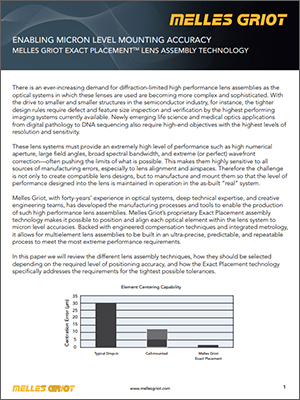Enabling Micron Level Mounting Accuracy

There is an ever-increasing demand for diffraction-limited high performance lens assemblies as the optical systems in which these lenses are used are becoming more complex and sophisticated. With the drive to smaller and smaller structures in the semiconductor industry, for instance, the tighter design rules require defect and feature size inspection and verification by the highest performing imaging systems currently available. Newly emerging life science and medical optics applications from digital pathology to DNA sequencing also require high-end objectives with the highest levels of resolution and sensitivity.
These lens systems must provide an extremely high level of performance such as high numerical aperture, large field angles, broad spectral bandwidth, and extreme (or perfect) wavefront correction—often pushing the limits of what is possible. This makes them highly sensitive to all sources of manufacturing errors, especially to lens alignment and airspaces. Therefore the challenge is not only to create compatible lens designs, but to manufacture and mount them so that the level of performance designed into the lens is maintained in operation in the as-built “real” system.
Melles Griot, with forty-years’ experience in optical systems, deep technical expertise, and creative engineering teams, has developed the manufacturing processes and tools to enable the production of such high performance lens assemblies. Melles Griot’s proprietary Exact Placement assembly technology makes it possible to position and align each optical element within the lens system to micron level accuracies. Backed with engineered compensation techniques and integrated metrology, it allows for multielement lens assemblies to be built in an ultra-precise, predictable, and repeatable process to meet the most extreme performance requirements.
In this paper we will review the different lens assembly techniques, how they should be selected depending on the required level of positioning accuracy, and how the Exact Placement technology specifically addresses the requirements for the tightest possible tolerances.
